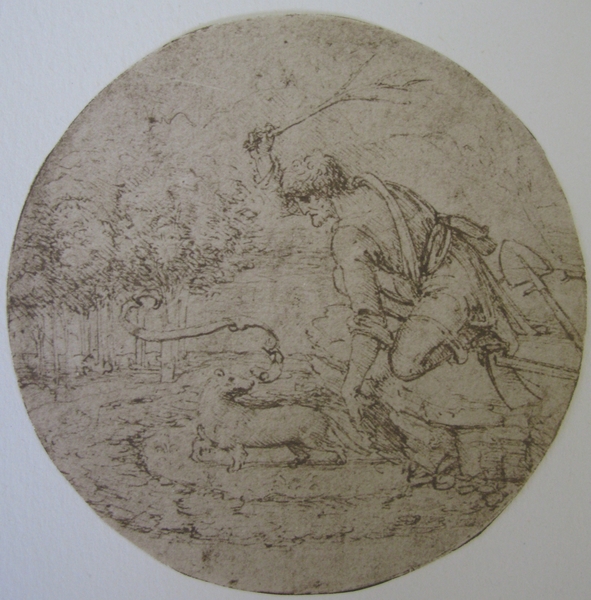The Ermine as an Emblem of Purity
Summary
A reproduction produced by the Vasari Society of a drawing by Leonardo da Vinci. This is a circular image showing a man leaning over an ermine with a branch in his hand, as though ready to club it. The is a spade and another kind of tool on the ground next to the man. The ermine appears to have emerged from a hole beneath where the man is kneeling, and is looking back towards the man. A blank scroll curls above the ermine's head, and there are some trees in the background. Text from the accompanying booklet produced by the Vasari Society: "No. 3 LEONARDO DA VINCI (b. 1452; d. 1519) THE ERMINE AS AN EMBLEM OF PURITY Collection of the Hon. A. Holland-Hibbert. From the George Hibbert Collection. Diameter 9.1 cm. (3 9/16 in.). This newly discovered little emblematic drawing by the great master has a special interest in connexion with a passage in one of his manuscripts preserved in the library of the Institute in Paris. The manuscript in question contains brief notes on the virtues and habits of animals, not founded in Leonardo's usual manner on observation, but purely on fanciful traditions handed down from antiquity and the Middle Ages. 'Bestiaries', that is compilations embodying such traditions, were numerous and popular. The special sources from which Leonardo drew his notes have been identified by a living Italian scholar, Dr. Gerolamo Calvi.¹ The principal source was an anonymous mediaeval treatise called Fiore di Virtù. Every animal, it was supposed, had some virtue of which it stood or might stand as the symbol, and the ermine stood for two, moderation (in the sense of abstemiousness) and purity. The note on the creature in Leonardo's own text is brief and would not of itself be enough to explain the drawing. It runs: 'The ermine from moderation never eats but once a day; it will rather let itself be taken by the hunters than take refuge in a dirty burrow, in order not to stain its purity.' But in turning to his source in the Fiore di Virtù we find a longer account which makes every point in the drawing clear. After telling about the ermine's abstemiousness and general dainty habits, the mediaeval writer goes on: 'when the hunters want to catch one they surround its burrow with mud and when it comes out they close the mouth of the burrow to prevent its going back; and when it sees the hunters it bolts; and when it comes to the mud it lets itself be caught rather than soil itself, so pure (literally, nice or well-bred) a creature is it.' The drawing shows us a landscape, part wooded and part bare, with the opening of the ermine's burrow in the face of a low rocky elevation: a man kneels just above and behind the opening; behind him lie the spade and mattock with which he has just spread a belt of mud on the ground in front of the burrow. The ermine has come out and turns refusing to face the mud; with his left hand the man stops its hole and in his right lifts a lopped branch to club it. The scroll near the creature's mouth was no doubt intended to be inscribed with some motto of purity. The drawing is fully finished and shows the master's hand unmistakably, though working perhaps with a little less than his usual fire. Its date may be supposed to be about 1494, the year when the Paris manuscript was written. Here is the actual text, as transcribed by Dr. Calvi, of the passage in the Fiore which tells of the ermine's passion for keeping itself unsoiled: 'Quando piove non ese mai de la sua tana: per non impegarsi de fango · e questo fa per sua zentileza · e mai non habita in loco humido · ma sempre in loco sciuto: e quando li cazadori lo voiono piare: eli circonda[no] tuta la sua tana de fango: E quando l'armellino ese fora · eli sara[no] la bocha de la tana: per che lo no posi retornar in la sua tana: E quando el vede i cazadori: el fuze: e quando zonze al fango · se lasa avanti par: che volersi impegar: tanto è zentile.' ¹ Gerolamo Calvi, Il manoscritto H di Leonardo da Vinci (il 'Fiore di Virtù) e l' 'Acerba' di Cecco d' Ascoli, Milan, 1898. S. C."
Object Name
The Ermine as an Emblem of Purity
Creators Name
Date Created
1913-1914
accession number
1933.396
Collection Group
Place of creation
Europe
Medium

